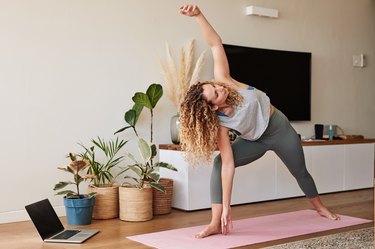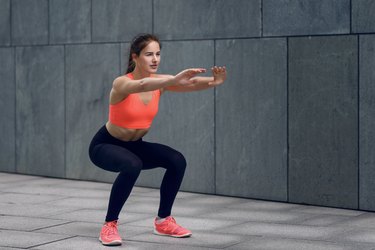
If you want strong, healthy legs, you might take a cue from the animal kingdom. More specifically, from frogs.
Frogs are known for their long, strong legs, which help them leap large distances and propel through water. So, for powerful gams, make like this active amphibian, and start doing frogger squats (also called frog squats).
Video of the Day
This squat variation — aptly named for its wide-legged froggy stance — is one of the best lower-body exercises you can do because it targets the trio of quads, glutes and hamstrings. And that's not all. Frog squats also strengthen your core, boost your cardio and improve your hip mobility.
Ready to hop to it?
How to Do Frogger Squats With Proper Form
Frog Squat
- Start by standing with your feet a little wider than shoulder-width apart and your toes pointed slightly outward.
- While maintaining an upright trunk, push your hips back and slowly descend into a squat. You should aim to squat a little below parallel.
- From here, clasp your hands and rest your elbows inside your knees, keeping your chest facing forward.
- Lean forward and push your hips into the air, feeling the tension in your hamstrings as you straighten your legs. Don’t completely lock out your knees at the top of the movement.
- Once you feel the tension build in your hamstrings, lower your hips back down into a squatted position with your chest facing forward.
Tip
“If you’re unable to achieve a below-parallel squat, try to do a half squat at first to help build the necessary strength and mobility needed to perform a frog squat at full depth,” says Jereme Schumacher, PT, DPT, a doctor of physical therapy at Bespoke Treatments in San Diego.
Similarly, if you have tight hamstrings, he recommends starting with a smaller range of motion to slowly improve your hamstring flexibility and mobility.
4 Benefits of Frog Squats
1. They Strengthen and Stabilize Your Legs and Hips
Like most squat variations, frog squats boast leg and booty-sculpting benefits.
Frog squats challenge your quadriceps throughout the entire motion to ensure stability in your lower body, Schumacher says. Plus, they fire up your posterior chain, strengthening your glutes and hamstrings, he says.
2. They Train Your Core
When performing a frogger squat, you must activate your core to maintain a neutral spine and flat back, Schumacher says.
"This will challenge your core muscles and lead to improvements in strength and stability," he explains.
3. They Build Your Cardio
When programmed properly, any body-weight exercise can enhance your cardiovascular ability, Schumacher says. And frog squats are no exception.
So, what's the best way to program frog squats to boost your endurance (and heart health)? "Focus on higher repetitions completed at a faster pace," he says.
4. They Improve Hip Mobility
Frog squats not only help you develop greater strength and stability in you lower body, but they also keep your hip joints healthy, Schumacher says.
"It's important to always challenge your joints in different ranges of motion, and frogger squats offer a safe variation to improve your overall hip mobility," he says.
This is especially important because many of us spend a lot of time sitting, which keeps our hip muscles in a shortened (read: tight) position.
More Great Exercises for Strong, Healthy Legs



